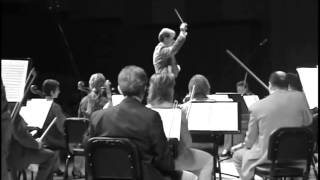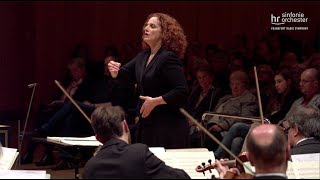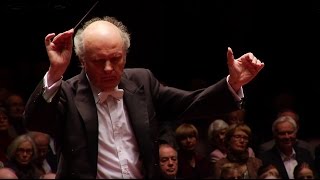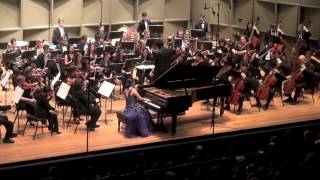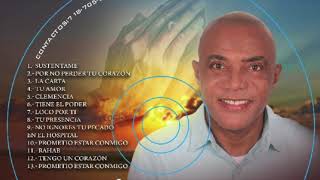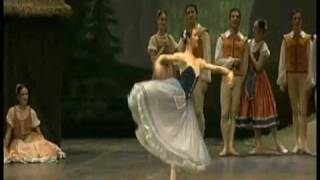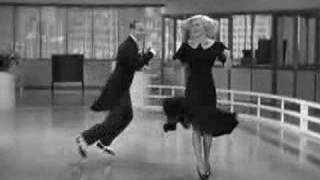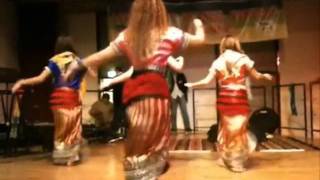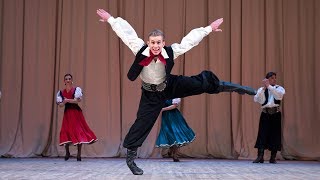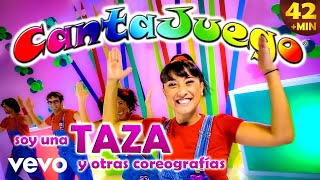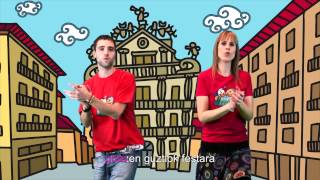Recommended music videos for initiation to classical music
Jean-Philippe Rameau (1683–1764) was a French composer, harpsichordist, and music theorist. He was highly influential during the Baroque era, replacing Jean-Baptiste Lully as the dominant composer of French opera. Rameau 's lyric works constitute the bulk of his musical contribution and mark the height of the French Baroque period , with his best-known work, the opera-ballet Les Indes galantes . However, his lyric works were largely forgotten until the mid- 20th century , as a result of the early music rediscovery movement; his harpsichord works were nevertheless ever-present. Rameau is generally regarded as the most important French musician of the pre-19th century ; he died in 1764 at the age of 81.
La nuit , The Hymn to the Night, is a harmonization by Joseph Noyon (1888-1962) of a theme from Jean-Philippe Rameau 's opera Hippolyte et Aricie , created in 1733 (duet of the priestesses of Diana, "Let us pay eternal homage", Act I, scene 3). The lyrics of the Hymn to the Night were written by the composer Édouard Sciortino (1893-1979); this music was popularized among the general public by the film The Choristes .
Today's performance is by the Segorbe Youth Musical Choir directed by Mª Dolores Pérez Torres .
Juan Crisóstomo de Arriaga (1806 - 1826), known by many as the Basque Mozart , was born in Bilbao . His father, Juan Simón , came from Errigoiti , a town near Gernika , where his mother, Maria Rosa , was from. His father, an organist from Berriatua , Bizkaia, moved to Bilbao to, as a good Errigotiarra, dedicate himself to business, with which he prospered and thus was able to promote Juan Crisóstomo 's educational development in Paris , where he died 10 days before his 20th birthday. The musical legacy, which has been preserved, consists of three string quartets, the octet Nada y mucho , written at the age of 11, the Overture No. 1 , the Symphony in D, several arias and cantatas as well as some motets and an opera, Los esclavos felices , written at the age of thirteen of which only its overture is preserved.
The Symphony in D minor is one of the most paradigmatic and representative works of the artistic legacy of Juan Crisóstomo de Arriaga , whose exact year of composition is around 1824, when Arriaga was in France , in the midst of his Parisian period. The symphony is structured in four movements, of which today we offer the third, which is structured in the classical mode: MINUETE (0´14´´) - TRIO (2´53´´) - MINUETE (4´22´´) and conducted by the German maestro Markus Theinert .
Niccolò Paganini (1782-1840) Italian composer, a leading figure in violin virtuosity. A child prodigy, his father forced him from a very early age to spend long hours studying the violin; by the age of fourteen, his teachers declared themselves incompetent to continue teaching him. As a violin soloist, he toured Italy, Vienna, Prague, Warsaw, Berlin, Paris, and London . Admired for his astonishing technique, he received accolades from Liszt and Berlioz , among others. His technique was so admired that it was said he had made a pact with the devil. He wrote numerous works for violin, as well as for guitar, viola, and bassoon. He died of tuberculosis at the age of 58.
Franz Liszt (1811-1886) was a brilliant Hungarian pianist and composer, whose works have survived the centuries; works for solo piano or concertante, as well as orchestral works, among which his symphonic poems stand out, a musical form of which he is the progenitor. Liszt 's father, an amateur musician, gave him his first piano lesson at the age of seven. In October and November 1820, at the age of nine, he appeared in concerts in Sopron and Bratislava . His father arranged for Franz to be presented to the Court of the House of Esterházy as a child prodigy. He was famous throughout Europe during the 19th century ; his contemporaries claimed him to be the most technically advanced pianist of his time and the greatest of all time.
La campanella (from Italian: The bell) is a piano study composed by Franz Liszt . It is Study No. 3 in Paganini 's Grandes Études and is written in the key of G-sharp minor (G#m). The piece is based on a theme from the last part of Paganini 's Violin Concerto No. 2 in B minor , a rondo in which the harmony is reinforced by the sound of a bell. It is a very technically challenging work, like the other studies in Paganini 's Grandes Études .
Today we offer a version for accordion by Sofía Ros , an internationally renowned Spanish accordionist.
Alan Menken (New York, 1949) is an American composer and pianist, best known for having composed the music for numerous films produced by Walt Disney Animation Studios such as The Little Mermaid, Beauty and the Beast, Aladdin and Pocahontas , for which he won two Oscars each. He has also composed the soundtrack for other Disney films such as The Hunchback of Notre Dame, Hercules, Home on the Range and Tangled . Menken has won a total of nine Oscars and has been nominated nineteen times.
" I've Got a Dream " is a song written by composer Alan Menken for the 2010 Disney animated film Tangled . The song is performed by the menacing male patrons of a pub known as " The Snuggle Ducky ", who initially intimidate Rapunzel and Flynn Rider after recognizing Flynn as a wanted fugitive; however, the patrons, led by Hook Hand , eventually subvert expectations by revealing their dreams and passions to Rapunzel , who, in turn, reveals her dream of seeing the floating lanterns in person. This endears them to them, and when the royal guards arrive, the patrons help Rapunzel and Flynn escape from the pub through a secret passage.
Today's performance is by the cast of Disney On Classic Fall Tour 2017 (Charis Vaughn, Maigan Kennedy, Lawson Young, Mara Jill Herman, David Wiens, Rob Hancock, Patton Chandler, and Stephen Markarian).
Recommended classical music videos
Georg Friedrich Haendel ( 1685-1759), born in Halle , Germany, is one of the leading figures in the history of music and, certainly, of the Baroque. He wrote numerous operas, cantatas and oratorios, among which we must highlight his masterpiece, the Oratorio Messiah . At the age of 18 he moved to Hamburg where he joined the Opera orchestra. After three years he traveled to Florence , and then to Rome . In 1710 he returned to Germany and from there to London where he achieved great success, which encouraged him to settle under the tutelage of various patrons. Although he always showed himself very jealous of his private life, there are innumerable indications that lead us to suppose his homosexual inclinations. In London he acquired his British nationality and was appointed manager of the Opera House until his death in 1759.
Dixit Dominus is a psalm set to music by George Frideric Handel using the Latin text of Psalm 110 beginning with the words Dixit Dominus ("The Lord said"). He completed the work in April 1707 while living in Italy . The work was written in the Baroque style and is scored for five vocal soloists (SSATB), five-part choir, strings, and continuo. The work was most likely first performed on 16 July 1707 at the Church of Santa Maria di Montesanto , under the patronage of the Colonna family.
Today we present it under the baton of French maestro Emmanuelle Haïm (1962), a harpsichordist and conductor specializing in Baroque music who has had relevant performances leading the Berlin Philharmonic, the Chicago Opera, and the BBC Proms , among other institutions.
Robert Schumann (1810-1856) was a German composer, one of the pillars of Romanticism . He studied piano, although due to an incurable injury to his right hand, he abandoned his piano career to focus on composition. He married Clara Wieck ("Clara Schumann"), daughter of his former teacher, a composer and prodigious pianist; both maintained a close friendship with Brahms . From the age of 23 he suffered several depressive episodes and hallucinations, with a suicide attempt in 1854. Until the age of 30, he only wrote piano works and lieder (songs); but encouraged by his wife, he dared to write more significant works and thus wrote several choral works, chamber works, orchestral works, among which his four symphonies, a dramatic poem, Manfred , whose overture we offer today, and an opera stand out.
Manfred is a symphonic poem written for narrator, soloists, chorus, and orchestra, based on Lord Byron 's poem Manfred . It consists of an overture, an interlude, and various numbers for solos and chorus; the overture is its best-known section.
Today we offer it under the baton of Marek Janowski , a Polish conductor specializing in Wagner , who was brought to Germany as a child by his German-born mother. He has conducted in the world's finest opera houses and with the highest-level orchestras in Europe and America . He is currently principal conductor of the Dresden Philharmonic .
Louise Farrenc (1804–1875) was a French composer, pianist and teacher, who studied piano with Anne Soria , then with Antoine Reicha , a professor at the Conservatoire de Paris , who taught her music writing (harmony, counterpoint), and later with Ignaz Moscheles and Johann Nepomuk Hummel . Farrenc taught piano at the Conservatoire de Paris , where she eventually received the same salary as her male colleagues. She was supported by the best musicians of her time, such as the violinist Joseph Joachim , and was twice awarded the Chartier Prize from the Institut de France , intended to reward the best chamber music compositions, in 1868 and 1869. She died on 15 September 1875 and was buried in the Montparnasse Cemetery.
Symphony No. 3 in G minor , Op. 36 , is a work by Louise Farrenc , the last of the symphonies she composed. It is the best known and most appreciated of her symphonies; composition that was completed in 1847 , two years after his Symphony in D major, Op. 35 (1845). Its premiere took place in Paris on April 22, 1849 , by the Orchestra of the Société des concerts du Conservatoire under Narcisse Girard .
Structure . The Symphony consists of four movements: I (1´23´´) ADAGIO - ALLEGRO .-. II (14´29´´) ADAGIO CANTABILE .-. III (25´15´´) SCHERZO VIVACE .-. IV (31´34´´) FINALE ALLEGRO
Today we enjoy it with the help of Finnish maestro Franck Mikko conducting the Radio France Philharmonic Orchestra.
Lowell Lieberman (New York, 1961) is an American composer, pianist, and conductor. At the age of 16, he performed his Piano Sonata, Op. 1 , at Carnegie Hall . He later studied at the Juilliard Academy with David Diamond and Vincent Persichetti , earning his bachelor's, master's, and doctorate degrees. His works combine elements of traditional tonality and structure with daring harmonies. Among his most successful are "Sonata for Flute and Piano" of 1987, " Gargoyles " for piano of 1989 and " Concerto for Flute and Orchestra " of 1992. Other notable works include a sonata for flute and guitar of 1988, four cello sonatas (most recently in 2008), the Second Piano Concerto of 1992, the opera " The Picture of Dorian Gray " (1996), a Second Symphony (2000), a Trumpet Concerto (2000), a Violin Concerto (2001), " Rhapsody on a Theme of Paganini " for piano and orchestra (2001) and the opera " Miss Lonelyhearts " (2006) which was commissioned as part of the festivities marking the Juilliard Academy 's centennial.
The Concerto is a musical form written for one or more solo instruments accompanied by an instrumental ensemble. It was Vivaldi who established the fundamental bases of its structure in three movements ( fast I - slow II - fast III ) and presented as a dialogue between the soloists and the instrumental ensemble. From Classicism onwards, especially from the foundations created by C.P.E. Bach , the first movement is built following the patterns of sonata form (exposition, development and re-exposition) , while the second and third movements adopt free and punctual forms. From the 20th century onwards, formal structures became more permissive.
Today we offer the Piano Concerto No. 2, Op. 36 by Lowell Liebermann in a performance by Yiding Isabelle Niu accompanied by the Stony Brook Symphony Orchestra conducted by Maestro Eduardo Leandro . The Concerto is structured, in an unusual arrangement, in four movements: I (0'48'') ALLEGRO MODERATO .-. II (13'29'') PRESTO .-. III (17'21'') ADAGIO .-. IV ( 26'57'') ALLEGRO.
Recommended music videos for all tastes
Therapie Taxi , sometimes stylized as Therapie TAXI , was a French pop rock and hip hop band formed in 2013. The band initially consisted of Adélaïde Chabannes de Balsac and Raphaël Faget-Zaoui (vocals), Félix Gros (guitar and keyboards) and Renaud Bizart (drums). Before their breakup in 2020, Therapie Taxi released two albums, two EPs and several singles, including the song " Hit Sale " featuring Belgian rapper Roméo Elvis , which was certified gold in France and Belgium .
Il Volo (English: "The Flight") is an Italian classical crossover / lyrical pop band. Formed in 2009, the group is a male vocal trio of singers: Gianluca Ginoble, Ignazio Boschetto and Piero Barone . In 2015, they won the Sanremo Song Contest and went on to represent Italy at the Eurovision Song Contest 2015, finishing third. The trio was formed after the three singers' participation in the second edition of the Rai 1 talent show Ti lascio una canzone in 2009. During the contest, they were assigned to sing a song together as a trio: O sole mio , which pleased the audience, who nicknamed them "i tre tenorini" (the three little tenor). After the performance, they decided to join forces and form a group called " Tryo ", which later became " Il Tryo " and finally " Il Volo ". They were the first Italian-born band to sign a contract with the American record label Geffen Records .
Christina Aguilera (born 1980) is an American singer, songwriter, actress, model, fashion designer, producer, and businesswoman. She began acting and singing at a young age, landing roles in theater productions and television shows, including Star Search and The Mickey Mouse Club . Aguilera 's work has won numerous awards, including six Grammy Awards and a Latin Grammy . Her songs address themes such as love, childhood, self-esteem, sexuality, feminism, and women's empowerment. She also has a wide vocal range of 4 octaves, making her known as "the voice of the generation." She was the best-selling single of the 2000s, along with Madonna .
Luis Manuel , is a Peruvian singer, who has developed his musical career within Peruvian cumbia. He achieved recognition for having joined the musical band Grupo 5 , where he remained between 2016 and 2020. Born on September 10, 1991 in Pacasmayo , from an early age, he showed his interest in music, in which he stood out for his singing gifts; He began his artistic career in the late 2000s, joining the musical groups La Idéntica de Chepén and Hermanos Silva , beginning his foray into Peruvian cumbia.
Recommended peculiar videos
Adolphe Adam (1803-1856) was a French composer born in Paris , son of the renowned pianist and professor at the Paris Conservatoire , Louis Adam , with whom he began his musical studies. At the age of 18 he entered the Paris Conservatoire and by the age of 20, he was composing songs for Parisian vaudevilles . His first successes came in adulthood with the ballet Giselle , which we offer today, and the opera Si j'étais roi . In total he wrote 40 operas, 14 ballets and various cantatas, hymns, masses, choruses, piano pieces, pantomimes, military marches and plays; of all these compositions, in addition to those already mentioned, it is worth highlighting the ballet Le Corsaire , and the world-famous Christmas carol Cantique de Noël , as O Holy Night . From 1849 until his death in 1856 he was a professor of composition at the Paris Conservatoire .
Giselle is a ballet in two acts with music by Adolphe Adam , choreography by Jules Perrot and Jean Coralli , and libretto by Théophile Gautier and Jules-Henri Vernoy, based on the play De l'Allemagne (1835) by Heinrich Heine . Giselle is a peasant girl of great beauty and extreme innocence; deceived and betrayed, she falls into a despair that will drag her towards madness and death. Giselle is one of the masterpieces of ballet blanc , a ballet scene in which all the members of the corps de ballet appear dressed in white; these white scenes are usually populated by ghosts, dryads, sylphs, fairies or similar creatures.
Today we present the First Act Variation , performed by Ukrainian Svetlana Zakharova , who currently performs as a prima ballerina in the world's finest theaters.
Tap dancing , also known as tap , is an American dance style in which the feet are moved rhythmically while performing a musical stomp. It originated from the fusion of clog dances from Ireland , Northern England , and Scotland , combined with dances practiced by African Americans. Indeed, in 1739, black slaves were prohibited from using percussion instruments ; this motivated them to perform the rhythms with their feet and hands. Dancers gathered to compete and to show off their best skills and movements. Thus, a new dance was born: American tap . The dancers relaxed the rigid Irish postures, used arms and shoulders to mark, and added new steps, since improvisation was the essence of this dance.
Kabyle Berber dance, or the dance of the free. Since ancient times, the Imazigh (plural of Amazigh), whose name means "the free," have fought for their untouchable freedom, and they do so to the extreme. Romans, Arabs, Ottomans, and French are just some of the peoples who tried to take away their most precious possession, the one that gives them their name. Despite oppression, they preserve their traditions and practice them with pride; from their cuisine and their diverse languages to their costumes and tattoos, their music, and their beautiful, joyful, rhythmic, colorful, and collective dances.
The Malambo is a traditional Argentine folk dance, belonging to the so-called southern or southern music . It originated in the Pampas around 1600 and is an exception among Argentine folk dances because it lacks lyrics; the music of a legüero bass drum and guitars (sometimes just the bass drum or percussion) accompany this dance, performed exclusively by men. There are no rules for performing a zapateo. Each combination of basic movements is unique and depends on the originality of the gaucho performing it. The zapateos are separated from each other by a foot stamp called "repique," which contains a quick, distinctive sound that indicates the end of one zapateo and the beginning of another.
Today we offer one of these dances choreographed for couples of both sexes by the Igor Moiseyev Ballet , a company born from the heart of Moscow's Bolshoi Theatre and currently one of the world's great ballet companies; a company that successfully combines the spontaneity of popular dance with the academicism of classical ballet.
Recommended music videos for children
Various Wikipedia articles have been used to write these texts.
The texts of Videomusicalis are written in Basque, Spanish and English.






